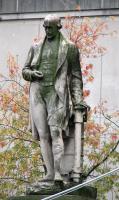Alexander Munro (1825-1871)
Statue by Munro in Berkeley Square.
Son of a dyer in Inverness, the talented Alexander Munro was noticed by his father s wealthy employer, the Duchess of Sutherland, and brought to London in 1848 to study sculpture under Charles Barry. He exhibited at the Royal Academy from 1849-70, and in the Great Exhibition of 1851. Munro became a specialist in portrait sculpture, and in statues of children. He was close to the Pre-Raphaelites, especially Rossetti, and there is something of Elizabeth Siddall, Rossetti's wife, in his female figures. His works in London include the fountains in Berkeley Square and by Hyde Park Corner (Boy and Dolphin). In Birmingham is a statue of James Watt (1866) and, in the Museum, The Sleeping Child, one of his Great Exhibition works, and his most successful sentimental piece, Paolo and Francesca. In Oxford there is a medallion of Millais at the Ashmolean, and architectural statuary in the University Museum - the figures of Galileo and Hippocrates, also Humphrey Davy and Liebnitz, Newton and Watt - the latter rather different to the Birmingham version.
Newton, in the Oxford Museum.
Munro's child sculpture feels a little sentimental to the modern taste, though the Victorians liked this sort of thing, and the fidelity of the work is exemplary - the figure of Young Romilly has nobility and feeling. Of the Oxford Museum statues, the Hippocrates is the best, severe, angular and spartan in delineation. His various portrait sculptures generally show this economy, dispensing with excess detail, that make his work almost ideal - his Dante in Girton College, and Benjamin Woodward, also in the Oxford museum, would be the best examples. The Paulo and Francesca is rightly his most celebrated work. But for me, a favourite work is the lovely fountain figure, a girl with a pitcher, in Berkeley Square. The majority of Munro's oeuvre is portrait sculpture, both busts and medallions, but a number of his known works have disappeared, his public sculptures are not numerous, and he died relatively young, in France, where he had taken to spending part of each year for his health.
Munro's statue of James Watt in Birmingham.


